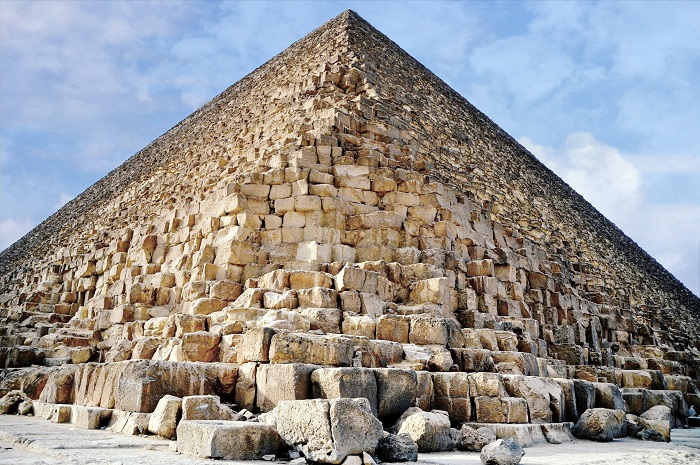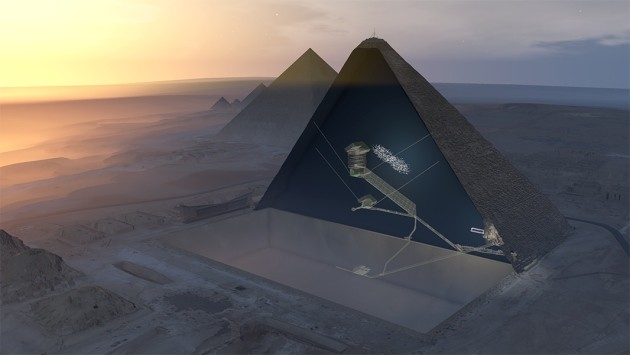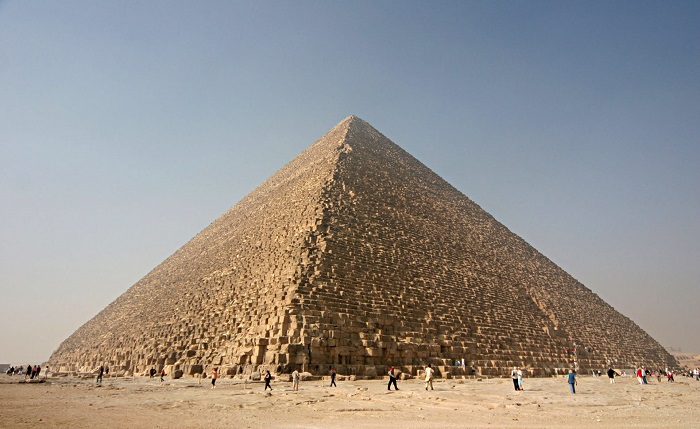ISABEL RUBIO ARROYO | Tungsteno
The Great Pyramid of Giza—also known as the Pyramid of Cheops—is the only wonder of the ancient world still standing, and remains largely an engineering enigma. Despite being one of the largest and oldest monuments on Earth, there is no consensus on how it was built or what secrets are still hidden within. We analyse the scientific evidence on how the Egyptians raised the pyramid, the world's tallest man-made structure for nearly four millennia, and how it has survived to the present day.
Two million two-ton blocks
For centuries, numerous researchers have tried to unravel the mystery of the construction of the Great Pyramid of Giza. Built by order of the pharaoh Khufu (known to the ancient Greeks as Cheops) round 2570 B.C. on the outskirts of Cairo, it was originally 146 metres high. More than two million limestone blocks were used to erect its structure and build the outer shell. These blocks weighed over two tons each and came from nearby quarries.
The reddish-pink granite blocks used in the central chamber came from a quarry in Aswan, some 800 kilometres from the site. These stones were transported down the Nile by boats and, once in port, were dragged on sledges to their destination. The ancient Egyptians used a trick to facilitate their transport, according to research published in the scientific journal Physical Review Letters: they wet the sand on which the sledges moved. With a precise amount of moisture they could reduce the friction and the number of workers needed.
Contrary to popular belief, there is no evidence that the pyramids of Giza were built by slaves (or by extra-terrestrials for that matter). Egyptian archaeologists have found several tombs of the workers who built the pyramids. The tombs, 2.74 meters deep, housed 12 perfectly preserved skeletons. "These tombs were built beside the king's pyramid, which indicates that these people were not by any means slaves. No way would they have been buried so honourably if they were slaves," says Zahi Hawass, the head of the excavation.
The way in which the Egyptians cut and moved the stones to build the pyramids "is still very mysterious," according to Kara Cooney, professor of Egyptian art and architecture at the University of California: "We still don't know how the ancient Egyptians lifted blocks weighing hundreds of tons up the sides of the pyramids." Some Egyptologists suggest that ramps were used, but it is unclear what system was employed: whether the ramps ran straight up the outer walls of the pyramid, around them, or inside the structure itself.

It is still unclear how the ancient Egyptians lifted blocks weighing over two tons up the sides of the pyramids. Credit: CDFSA.
Technology to reveal inner mysteries
To unravel all the unknowns within the Great Pyramid of Giza without desecrating it, all kinds of technologies have been used, from muon tomography to infrared thermography. Researchers have discovered, for example, that the inner masonry of the Cheops pyramid is surprisingly irregular and full of holes. An article published in Nature compares it to Swiss cheese.
The pyramid hides three main chambers inside: the King's chamber, the Queen's chamber and a subterranean chamber. It also has several passageways and passages. But although this pharaonic structure has been analysed for many years, we still don’t know all the secrets hidden inside. A few years ago, a team of scientists obtained images of the pyramid using muons—by-products of cosmic rays that are only partially absorbed by the stone. With this technique, it is possible to detect voids noninvasively. "We tried to do for the pyramid what a doctor can do with X-rays," explains Mehdi Tayoubi, one of the researchers.
The scientists published their findings in 2017 in the scientific journal Nature: there is a huge void more than 30 metres long that had never been detected before. This is, according to the authors of the study, the first major inner structure found in the Great Pyramid since the 19th century. It is still unclear what the purpose of this cavity was. While some Egyptologists claim that it is not a new room, others suggest that it could have been an internal ramp used to move large blocks.

A team of scientists found a huge void more than 30 meters long inside the Great Pyramid a few years ago. Credit: ScanPyramids.
The only wonder of the ancient world still standing
"Man fears time, but time fears the pyramids." This Arab proverb found in the book Giza and the Pyramids, written by Egyptologists Mark Lehner and Zahi Hawass, is a reminder that the pyramids of Giza have endured for more than 4,000 years. The Pyramid of Cheops is to this day the only wonder of the ancient world still standing.
The seven wonders of the ancient world were a set of architectural and sculptural works that various Greek authors, especially in the Hellenistic period, considered worth visiting. In addition to the Great Pyramid of Giza, the Hanging Gardens of Babylon, the Temple of Artemis at Ephesus, the Statue of Zeus at Olympia, the Mausoleum at Halicarnassus, the Colossus of Rhodes and the Lighthouse of Alexandria are also on the list. While some were destroyed by plundering troops, others suffered earthquakes and one was even set on fire.
Although the Great Pyramid of Giza has survived for millennia, it is not free of risk. The jihadist group Islamic State has on occasion threatened to destroy the Sphinx, the pyramids of Giza and "the ancient monuments built by infidels." In addition, a number of archaeologists and heritage experts have criticised the construction of two major highways in the vicinity of the pyramids, on the grounds that they may pave over unexplored sites, generate pollution that could corrode the monuments and expose closed areas full of hidden archaeological treasures to looting. Combating any threat to the pyramids of Giza is paramount to ensuring that this wonder of the ancient world remains standing for many millennia to come.
· — —
Tungsteno is a journalism laboratory to scan the essence of innovation. Devised by Materia Publicaciones Científicas for Sacyr’s blog.
